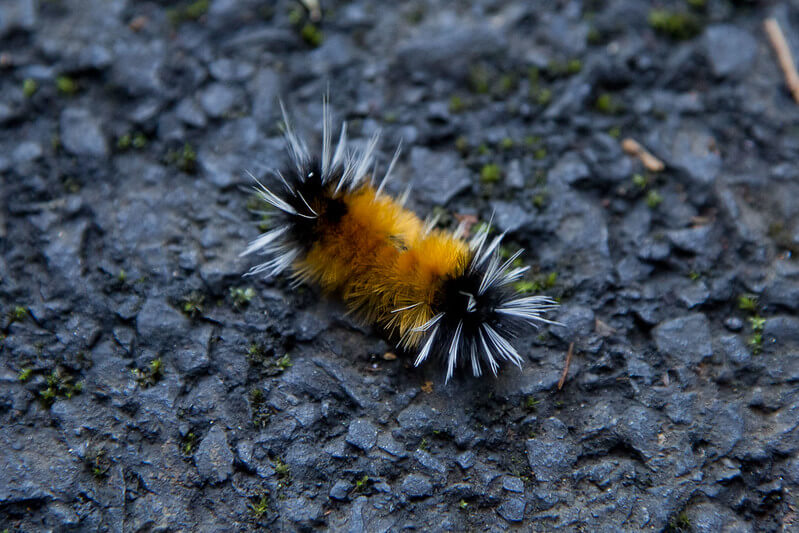The Fuzzy Orange Spot of Fall
By Tricia Erickson
Broadcast 9.20 & 9.23.2023

“Woolly bear” caterpillar, the larval form of the spotted tussock moth (Lophocampa maculata). Photo by Peter Pearsall/U.S. Fish and Wildlife Service, CC BY-NC 2.0.
Listen:
I had visited Glacier National Park in the summer plenty of times to see its rainbow of wildflowers spread across the mountains. Still, I had never seen the change from summer to autumn colors until I hiked the Highline Trail late last September.
The valley popped with changing fall colors: yellow shone from the cottonwoods and aspens, while oranges and reds of various vegetation dotted the mountainside. It was my last chance to visit the mountains before the Going-to-the-Sun Road closed in just a few days, signaling winter’s arrival.
The first half mile of the appropriately named Highline Trail features a narrow path hugging the mountain’s steep side and overlooking the Park’s main road. After navigating this more treacherous section, I relaxed in a wooded area filled with conifers and orange-berried mountain ash. A small spot of orange in the middle of the trail caught my eye. It wasn’t a leaf or a berry; it was tiny and moving! As I neared the curious sight, I discovered it was a fuzzy caterpillar. It was about an inch long, black on its front and back ends, with white tufts of hair and a bright orange middle. I had never seen anything like it.
Once I returned home to wifi and reception, I discovered I had seen a type of woolly bear caterpillar, specifically a spotted tussock caterpillar. The larva I had seen was in its fifth instar, meaning it had molted and changed coloration four times. It was in its final stage before encapsulating itself in a cocoon and later emerging as a moth.
During my research, I realized this moth’s common names, spotted tussock or yellow-spotted tussock, are misleading and can confuse novice caterpillar identifiers like myself. While it has the word “tussock” in its name, it is a tiger moth, not a tussock moth. “Tussock” refers to tufts of hair that resemble tussocks, or clumps of grasses, that grow thicker or longer than the grasses surrounding it. This caterpillar earned the name because of its thick fuzzy hair, though it is not a true tussock caterpillar. Why does it matter if it is a tussock or a tiger caterpillar? True tussock caterpillars have hairs that sting or are barbed, which can cause skin irritation in humans. While tiger caterpillars may have hair, the hair does not have stinging capabilities.
The spotted tussock caterpillar I saw on the Highline Trail likely transitioned to the pupa or cocoon stage shortly after my hike, as the larva or caterpillar stage typically lasts from July through September. The larvae love to feed on the leaves of hardwood trees, including willow, poplar, oak, birch, maple, and alder. Once the caterpillar enters the pupa stage, typically in the fall, it will overwinter in its cocoon. In the spring, a brown moth with tan spots on its forewings and a wingspan of about one-and-a-half inches will break free from the cocoon. The moth is rather drab and much less eye-catching than its bright and fuzzy larva stage. The adult will only live for a few days, during which it will mate, lay eggs if a female, then die.
Now that winter has descended, I sit at home staring at the snow that has me hibernating inside. I often reflect on my time in Glacier and how grateful I am that I got to experience the fall colors of the Park. I think about that little fuzzy orange spot in the middle of the trail. The vibrant-colored caterpillar is also hibernating in its cocoon this winter, resting, transforming. It is preparing for a warm spring day to emerge, much like I am.
Every week since 1991, Field Notes has inquired about Montana’s natural history. Field Notes are written by naturalists, students, and listeners about the puzzle-tree bark, eagle talons, woolly aphids, and giant puffballs of Western, Central and Southwestern Montana and aired weekly on Montana Public Radio.
Click here to read and listen to more Field Notes. Field Notes is available as a podcast! Subscribe on Apple Podcasts or wherever you listen to podcasts.
Interested in writing a Field Note? Contact Allison De Jong, Field Notes editor, at adejong [at] montananaturalist [dot] org or 406.327.0405.
Want to learn more about our programs as well as fun natural history facts and seasonal phenology? Sign up for our e-newsletter! You can also become a member and get discounts on our programs as well as free reciprocal admission to 300+ science centers in North America!












